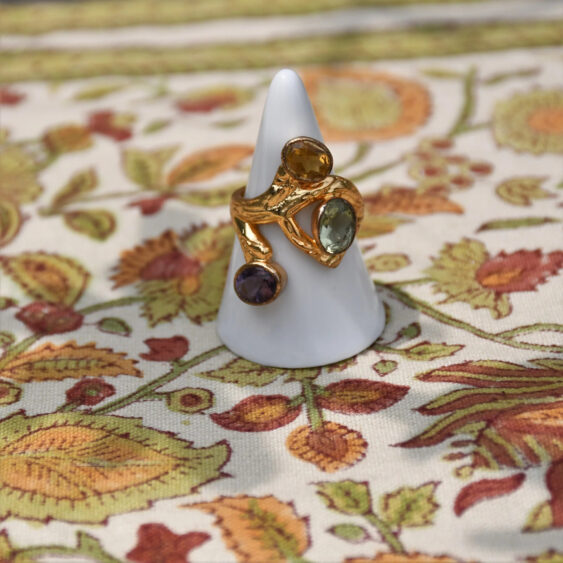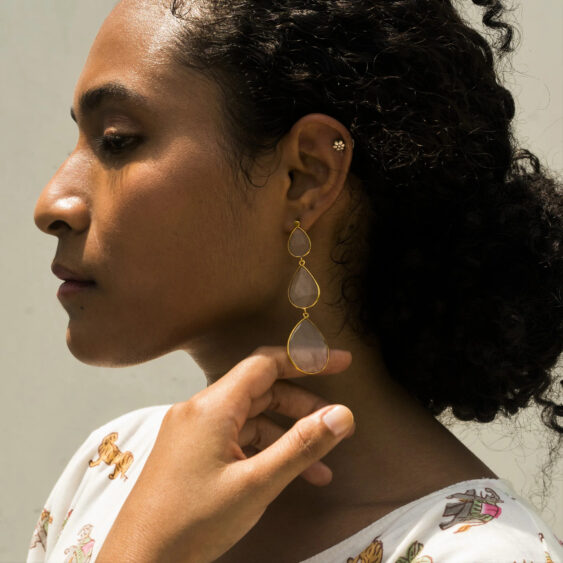How Soho House is Rethinking Creative Infrastructure in India
India’s creative scene is having a moment—driven not just by legacy craft but by a new generation of artists, designers, filmmakers, and cultural thinkers reshaping how and where creativity happens. At the heart of this shift is a growing need for spaces that don’t just host the creativity, but help shape the ecosystem around it. That’s where establishments like Soho House come in. With their first outpost in Mumbai and an expanding network through Cities Without Houses, the global members’ club is adapting its model to meet the unique energy of India’s cities and its creative communities. Blur The Border spoke to Kelly Wardingham, and Sita Wadhwani about what makes India’s cultural landscape distinct, the gaps they hope to fill, and how they’re rethinking what creative infrastructure can look like.

Blur: What makes India’s creative ecosystem unique and what has led Soho House to increase its physical expansion in different cities in India and also Cities Without Houses?
Kelly: India’s creative ecosystem is vibrant, fast-evolving, and deeply layered; drawing from centuries of craft, storytelling, and cultural nuance while constantly pushing into new forms of self-expression. From independent cinema to textile innovation, digital content to contemporary art, the sheer range of creativity coming out of India right now is unlike anywhere else in the world. Soho House Mumbai, since opening its doors six years ago, has organically become a home for this energy. As our first House in Asia, we’ve been excited to see our creative community in Mumbai redefine what it means to be a modern creative in India.
In the past year alone, we’ve hosted everything from artist residencies and member mixers to landmark industry moments like our MAMI Industry Programme, which included a day-long pitch session where screenwriters and authors presented original work for on-screen adaptation. Just last week, Women of Music India brought Andrew Gould (President of Music Publishing for Roc Nation) to the House for a fireside chat, giving our members passionate about the music industry a rare chance to connect, ask questions, and gain insight into scaling their careers.
Feedback from members continues to affirm the need for more such spaces; places that are creatively charged, personally grounding, and community-first. We’re now building on this foundation by growing our presence both physically and through Cities Without Houses (CWH), starting with Delhi and Bengaluru. Each of these cities brings its own creative pulse, and we’re excited to co-create local programmes, pop-ups, and member moments that reflect the culture, talent, and personality of each place.


MAMI at Soho House, Mumbai
Blur: What are the biggest gaps you see in India’s creative infrastructure, and how do you see the role of Soho House in bridging them beyond just offering spaces and events?
Kelly: One of the biggest gaps in India’s creative landscape is access. Whether that’s access to mentorship, cross-industry collaboration, or simply the right room to share ideas and be heard. There’s no shortage of talent, but there’s often a lack of structure around how creative professionals connect, grow, and sustain a long-term practice.
Soho House can play a meaningful role here - not just by hosting events, but by building frameworks that foster deeper exchange. There’s also a gap when it comes to business literacy in the creative space - knowing how to price work, pitch ideas, or build something long-term.
That’s where we see our role going beyond just being a beautiful space. We regularly host masterclasses with seasoned professionals - people who’ve done the work and are open to sharing what they’ve learned. One example is Business Lounge with Ayesha Soodha, a recurring series where members dive into the fundamentals of building a business. From setting up your company to managing finances and growing a brand. It’s practical, generous, and driven by real experiences.
Soho House Mumbai also runs an annual Mentorship Programme with Own Academy, offering young creatives 12 weeks of guided, project-based support with mentors across design, film, fashion, and more. It’s about turning raw potential into something tangible, with the right support system in place. Over time, the aim is to be more than a venue. We want to be an enabler of mentorship, of new work, of unlikely collaborations. A space where creative ambition meets real-world opportunity.
Blur: With social media and digital platforms making global creative networking more accessible, what unique value does a physical creative community like Soho House provide?
Kelly: While digital platforms can connect creatives across the world, there’s still no substitute for the kind of trust, chemistry, and collaboration that comes from meeting in person. At Soho House Mumbai, we’ve spent the last five years curating experiences that foster exactly that - real connection, creative exchange, and long-term collaboration among members.
From intimate networking evenings and member mixers to hands-on masterclasses with directors, writers, and producers, the House offers regular opportunities for members to meet others in their field; or discover someone doing something entirely different. Members have attended private screenings followed by Q&As with actors like Ali Fazal and Richa Chadha, swapped scripts at screenwriting workshops, and even connected over biodynamic wines at food and film-led programming.
Our programming is designed to support both emerging and established talent. Highlights have included ALP, a weekend-long short video festival curated by Reema Maya; fashion panels with Gaurav Gupta, Akshat Bansal, Shubhika Sharma, and Hanut Singh; and live sets by international artists like Parra for Cuva, Matt FX, Guy Williams, Marie Lung, and Jay Carder. The House has also been a creative launchpad, for instance, during her Soho Residency, Ambika Nayak wrote and released her track ‘On My Own’ directly from the House.


Soho House, Mumbai
Blur: What drives your selection of cities for physical expansion and Cities Without Houses, including New Delhi, Goa, Jaipur, Hyderabad, Bengaluru, and Kolkata?
Kelly: India’s cultural heritage is currently in the process of being revived and represented to a modern globalised world. Building member communities in six cities across the length and breadth of the subcontinent allows us to tap into a great diversity of creative industries and practices.
We engage with art, design, literature, couture and classical music in New Delhi. Goa is a tropical garden of creativity with pandemic settlers from all parts of the country experimenting with yoga and wellness, electronic music and the culinary arts. There is a newfound respect for what is ancient and authentic and so suddenly Jaipur and Kolkata are no longer staid tourist destinations but modern stalwarts of India’s oldest arts and craft traditions. In contrast, Bengaluru is the modern tech capital of India and technology is considered by us to be an innovative and hence inherently creative industry.
So in each one of these cities there is a cultural energy that, when it meets the aspirations of an emerging entrepreneurial class and second generation family businesses, creates endless possibilities for collaboration.

Blur: In Cities Without Houses, the first event—‘Breathing Room’—was held in New Delhi. What was the curation process like, to build up the event how do you see it expanding and evolving in the coming years?
Sita: With our member-only events we aim to bring the flavour and experience of Soho House to our Cities Without Houses (CWH). Through focused curation on three levels: creative concept, creative team and guest list.
Our contribution to India Art Fair week was this concept of breathing space, the secret ingredient to a great art fair experience. The vision for Breathing Room was for artists to come together to underline a universal, vital and intangible element of any art practice: space for reflection.
To bring such creative concepts to life we love to collaborate directly with our membership community. Indeed we prioritise it, and that is one of the benefits of being a Cities Without Houses member. The concept of Breathing Room was invented by a CWH New Delhi Committee member, the event creative director and the artist whose art book we launched at the event, are member and founder member of Soho House Mumbai respectively.
Lastly, our curated guest lists are always made up of member creatives from around the city, country and often the world. As was the case with Breathing Room in partnership with India Art Fair, where our partner’s guestlist of artists and art professionals from around the world mixed with our creative membership from around the world in town for the fair, in a Soho House-style space. That’s a room you can’t easily replicate!


'Breathing Room', Soho House in collaboration with India Art Fair
Blur: This initiative marks a shift from the exclusive traditional club model to a community that prioritizes and celebrates creativity. What impact do you hope to see on the creative community, their public perception, and the broader cultural landscape?
Sita: The intention is to reshape how creative work (and creative people) are seen and supported. Moving away from the idea of exclusivity for the sake of it, we’re building a space where access is based on creative contribution, not just social capital. That shift creates room for more meaningful exchange, more cross-disciplinary collaboration, and more visibility for voices that might otherwise stay on the margins.
Culturally, the goal is to normalize the idea that creativity deserves infrastructure. That it deserves investment, attention, and space to grow. We hope that by doing our bit, through mentorship programmes, workshops, consistent programming, and peer-led support, we encourage other spaces to do the same, and help raise the standard for how creative work is nurtured across the country.
As India’s creative economy continues to evolve, the need for intentional spaces—where ideas are exchanged, careers are built, and community is prioritized—feels more important than ever. Soho House offers something rare: a space that brings together access, mentorship, and community —rooted in local culture and connected to a global network. Such initiatives in India signal that the country's future is being actively shaped, and more importantly, shared.



